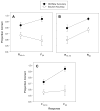Recollection can be weak and familiarity can be strong
- PMID: 21967320
- PMCID: PMC3345268
- DOI: 10.1037/a0025483
Recollection can be weak and familiarity can be strong
Abstract
The remember-know procedure is widely used to investigate recollection and familiarity in recognition memory, but almost all of the results obtained with that procedure can be readily accommodated by a unidimensional model based on signal-detection theory. The unidimensional model holds that remember judgments reflect strong memories (associated with high confidence, high accuracy, and fast reaction times), whereas know judgments reflect weaker memories (associated with lower confidence, lower accuracy, and slower reaction times). Although this is invariably true on average, a new 2-dimensional account (the continuous dual-process model) suggests that remember judgments made with low confidence should be associated with lower old-new accuracy but higher source accuracy than know judgments made with high confidence. We tested this prediction--and found evidence to support it--using a modified remember-know procedure in which participants were first asked to indicate a degree of recollection-based or familiarity-based confidence for each word presented on a recognition test and were then asked to recollect the color (red or blue) and screen location (top or bottom) associated with the word at study. For familiarity-based decisions, old-new accuracy increased with old-new confidence, but source accuracy did not (suggesting that stronger old-new memory was supported by higher degrees of familiarity). For recollection-based decisions, both old-new accuracy and source accuracy increased with old-new confidence (suggesting that stronger old-new memory was supported by higher degrees of recollection). These findings suggest that recollection and familiarity are continuous processes and that participants can indicate which process mainly contributed to their recognition decisions.
2012 APA, all rights reserved
Figures










References
-
- Aggleton JP, Vann SD, Denby C, Dix S, Mayes AR, Roberts N, Yonelinas AP. Sparing of the familiarity component of recognition memory in a patient with hippocampal pathology. Neuropsychologia. 2005;43:1810–1823. - PubMed
-
- Atkinson RC, Juola JF. Factors influencing the speed and accuracy of word recognition. In: Kornblum S, editor. Attention and performance IV. New York: Academic Press; 1973. pp. 583–612.
-
- Bamber D. State-trace analysis: A method of testing simple theories of causation. Journal of Mathematical Psychology. 1979;19:137–181.
-
- Banks WP. Recognition and source memory as multivariate decision processes. Psychological Science. 2000;11:267–273. - PubMed
-
- Buchner A, Erdfelder E, Vaterrodt-Plünnecke B. Toward unbiased measurement of conscious and unconscious memory processes within the process dissociation framework. Journal of Experimental Psychology: General. 1995;124:137–160. - PubMed

